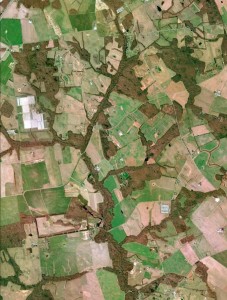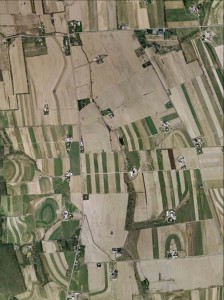Most of the time, nutrients are viewed as a positive and essential part of life. However, excess amounts of a nutrient, like nitrogen, can create major ecological problems for the Chesapeake Bay and other aquatic ecosystems. Too much nitrogen leads to an abundance of microscopic plant growth in the water. When the algae die and decay, they consume the oxygen that other organisms need to thrive.
Much of the Bay’s nitrogen pollution comes from farms where rainwater carries nitrate, a form of nitrogen, from fields into streams that drain into the Bay. For years, ecologists have noted that forests and wetlands growing between croplands and streams can reduce the amount of nitrate that reaches the waterways. Scientists have measured nitrate removal by these “riparian buffers,” but only in small study areas.
A new Smithsonian study published in Ecological Applications is the first to demonstrate and quantify the watershed-wide impact of riparian buffers on stream nitrate levels. “Until now, no one has measured overall nitrate removal by all the riparian buffers in a watershed,” said Donald Weller, an ecologist at the Smithsonian Environmental Research Center. “Our new analysis calculates how much nitrate buffers now keep out of streams and estimates how much buffer restoration could further reduce stream nitrate levels,” added Weller.
Current plans to protect the Chesapeake Bay include planting trees along hundreds of miles of streams. This study provides realistic limits for how much these buffers might further reduce nitrate pollution, and it helps identify where buffer restoration can offer the greatest additional nitrate removal.
SERC is a pioneer in the field, with riparian buffer research dating back to the early 1980’s. Weller developed the new analysis with Matthew Baker, an assistant professor in geography and environmental systems at the University of Maryland Baltimore County, and SERC ecologist Thomas Jordan. Together, they realized that existing models and analytical methods did not accurately represent how riparian buffers control discharges of nutrients from watersheds.
“Common methods for measuring riparian buffers in watersheds didn’t tell us whether or not the buffers were positioned to intercept nutrients coming from croplands, and empirical watershed models couldn’t estimate nutrient removal in buffers” said Weller.
The scientists developed new geographic methods to identify riparian buffers along flow paths that connect croplands to streams. Then they built statistical models that estimate nitrate losses from croplands, nitrate removal in buffers and stream nitrate levels. The team tested the new models on 321 watersheds that lead to the Chesapeake Bay.
Weller and his colleagues found that existing buffers in the study watersheds remove an average of 16 percent of the nitrate that flows from croplands. Furthermore, they estimated that replanting missing riparian buffers downhill from croplands might reduce nitrate concentrations in streams by up to 32 percent. The additional nitrate removal by restored buffers could significantly improve water quality in the Chesapeake Bay.
The team’s analysis also revealed that buffers in three physiographic provinces of the Chesapeake drainage were not equally efficient in removing nutrients. Buffers in Coastal Plain watersheds removed nearly twice the amount of their nitrate inputs than buffers in the Piedmont province and almost ten times more than buffers in the Appalachian Mountains. Coastal Plain buffer restorations will clearly reduce nitrate delivery to the Bay. Piedmont buffers are less efficient, but receive higher inputs from cropland, and more Piedmont cropland currently lacks buffers. Therefore, widespread buffer restoration in the Piedmont could yield the largest reduction in nitrate delivery to streams.
— By Lorien Godsey



